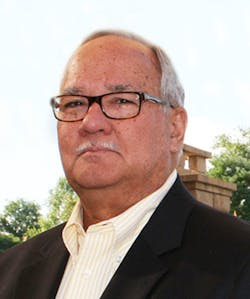Listen closely, you may hear injection molding's future
One of the highlights for me at NPE was an opportunity to spend an hour with Helmar Franz, executive director and chief strategy officer for Haitian International Holding Ltd. Franz was being interviewed for our monthly In Other Words feature (page 86) but he had some thought-provoking things to say beyond the scope of that article.
Professor Franz, as he is known to colleagues, has a reputation for being able to predict trends in machinery markets. One person who works with him likes to tell a story about how he predicted some years ago that energy consumption would become an important selling point for molding machines. Fast forward to NPE 2015 and nearly every machinery maker touted the energy-saving features of its machinery.
What's the source of his insight? He is a voracious reader, particularly of newspapers and magazines, but during our interview he also said that he listens to customers. It is interesting that he says he "listens" rather than "talks" to customers. But the key, I think, is his ability to listen and observe and then project how something unfolding in one area might evolve in the plastics industry.
He described three challenges ahead for injection molding machinery makers:
"First, development of the basic process of injection molding is missing. This is a little disappointing," says Franz, who started in the plastics industry as a development engineer. Very little has changed with injection molding machines in the past decade, he says. Machinery makers have been content to "add another injection unit and robot and trimming device" to make a spectacular work cell. But these are things originated from customers' ideas and innovation. "We are still machine tool makers. We should care about our machines," says Franz.
By way of examples, he points out that injection molding machines still use a screw for plasticizing and for injection — two processes that have nothing to do with each other. Another example is the industry's failure to lightweight injection molding machines, much in the way significant weight has been removed from large cutting machine tools. We have been satisfied with using bigger motors to move the unnecessary weight.
Second, machinery makers will have to embrace "cross technology." There will be a combining of different processes to manufacture a part, he predicts. "Processes other than injection molding are somewhat underrepresented at the moment. For example, making some interior auto parts on a thermoforming machine is better than using a big injection molding machine. So we need to combine the two processes to get the best part."
Third is the future of machinery manufacturers. "This is the same question that suppliers of mobile phones asked themselves some years ago," he says. "You sign a contract for service and get the phone for $1. That means you sacrifice some of your emotional connection to the telephone, but you get it for $1 so you don't care if it is black or white. If you want the extra features of an iPhone, you (not the service provider) pay extra. For the mobile telephone maker, it means much bigger scale of economy and reduction of complexity.
"I have read about a similar development in cars. In the coming years, if you subscribe to the Google navigation system, you might get an Audi or Mercedes or BMW for free. You will not be able to get your Audi with gray or beige seats. Whatever the color seating will be is OK because you get the car free of charge.
"In my opinion, this is very smart. The automakers can capitalize on complexity reduction and in the ability to recycle the car," Franz says.
It is hard to imagine a time when a supplier — say a resin supplier (my example, not Franz's) — gives a molder an injection molding machine to use with its resin. But if Franz thinks it's possible, I would not be too quick to dismiss the idea.
"We are a conservative industry, but what happened to telephones and what will happen to cars, why shouldn't it happen to molding machines?" he asks. Time frame? "Five or six years," he says.
Keep in mind that these are not ideas we overheard at the NPE beer garden in South Hall. Haitian sold about 27,000 injection molding machines in each of its last two fiscal years — far more than any other molding machinery company. In the 10 years since joining Haitian, Franz has been one of the key architects of its rise to global prominence in the molding machinery market.
This could give huge scale to machinery manufacturers willing to build high-quality, general-purpose molding machines. For the molder, it would mean a big change in how it deploys capital and competes for new projects.
It is interesting to think about.
Ron Shinn, editor
About the Author
Ron Shinn
Editor
Editor Ron Shinn is a co-founder of Plastics Machinery & Manufacturing and has been covering the plastics industry for more than 35 years. He leads the editorial team, directs coverage and sets the editorial calendar. He also writes features, including the Talking Points column and On the Factory Floor, and covers recycling and sustainability for PMM and Plastics Recycling.


